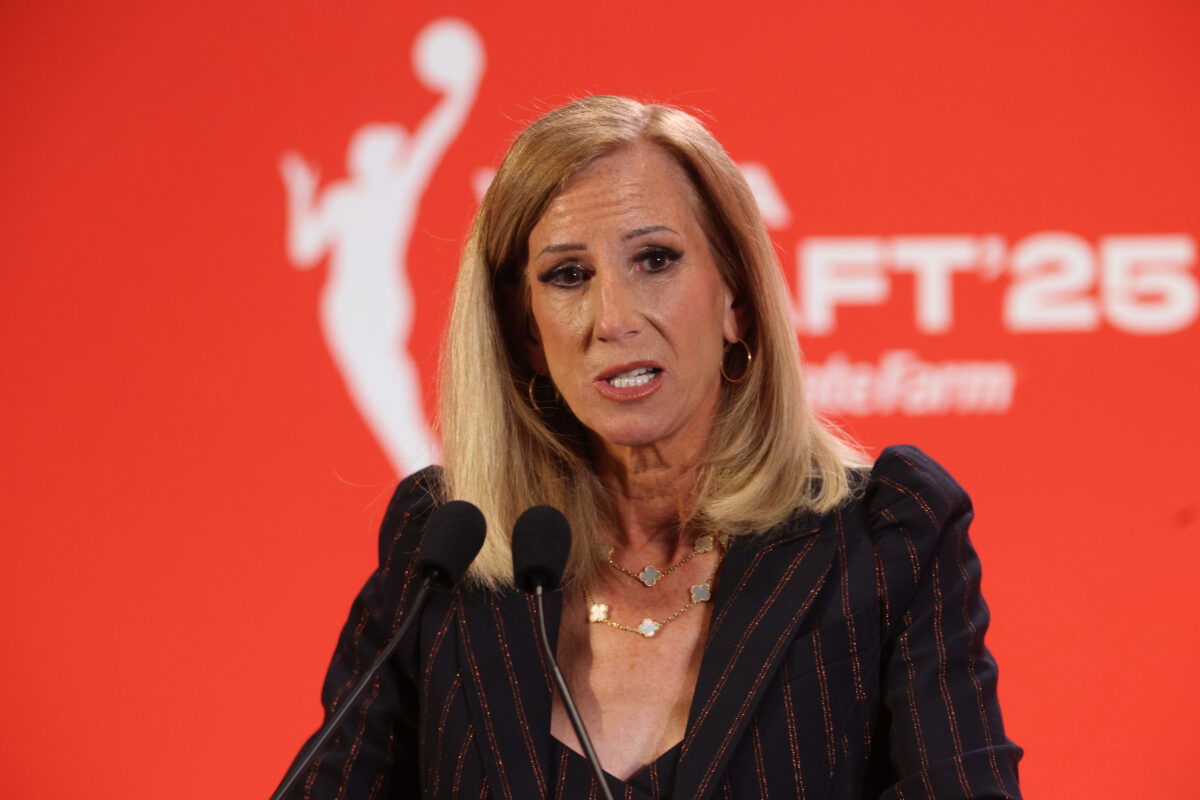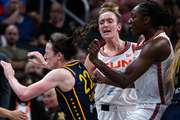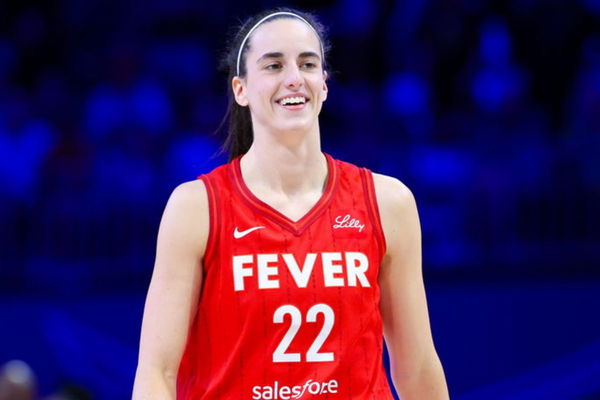
Imago
Apr 14, 2025; New York, New York, USA; WNBA commissioner Cathy Engelbert talks to the media before the 2025 WNBA Draft at The Shed at Hudson Yards. Mandatory Credit: Vincent Carchietta-Imagn Images

Imago
Apr 14, 2025; New York, New York, USA; WNBA commissioner Cathy Engelbert talks to the media before the 2025 WNBA Draft at The Shed at Hudson Yards. Mandatory Credit: Vincent Carchietta-Imagn Images
The WNBA is expanding rapidly–but maybe a bit too fast? By 2030, the league plans to introduce three more franchises, on top of the already-announced teams in Portland and Toronto. Last year, WNBA Commissioner Cathy Engelbert shared that she was “pretty confident” the league would grow to 16 teams by 2028. This came after plans were already in place to gradually expand to 15 teams by 2026.
Watch What’s Trending Now!
The Golden State Valkyries have already begun scripting history for their franchise, while new teams from Toronto and Portland are set to join the league next season. That’s five new teams in just a few years. On the surface, it sounds amazing–right? More cities, more fans, more opportunities for the players!
You might be surprised to learn that the responses we received from fans through ES’ flagship newsletter, She Got Game, don’t quite align with the mainstream narrative! Surprised? Well, there are many reasons to not like the move, and we will get to them. But before diving into the challenges, let’s take a moment to talk about the teams that have been announced. The WNBA is clearly tapping into markets that already have a solid foundation!
ADVERTISEMENT
Full-Circle Moment: WNBA Goes Back to Where It All Began
The WNBA recently confirmed that by 2030, three new franchises will be introduced in Cleveland, Detroit, and Philadelphia. What’s interesting about them is that all three of these cities have a history with women’s basketball. Didn’t know that? Don’t worry, we’ve got you covered! Here’s everything you need to know about these cities and their WNBA past.
Cleveland- Cleveland Rockers
ADVERTISEMENT
The Cleveland Rockers were one of the WNBA’s original eight franchises, launching in 1997 under the ownership of Cavaliers owner Gordon Gund. But by the end of the 2003 season, the Gund family decided they no longer wanted to operate the team, citing low revenue and underwhelming attendance figures. With no local buyer stepping in, the Rockers were forced to fold in December 2003. As for the players? They found new homes through a dispersal draft held in January 2024.
Top Stories
Cowboys Fire Defensive Coordinator Matt Eberflus: Contract, Salary, NFL Earnings & More

Huge Fire Destroys Over 125-Year-Old Golf Club Designed by 5x Open Winner in London – Report

Scottie Scheffler’s Caddie Shares Cryptic Message as He Bids Fans ‘Goodbye’

Russell Wilson Announces Retirement Stance as Giants QB Shares Hidden Injury News

Marina Mabrey Is Raising Eyebrows Again With Fiery Unrivaled Confrontation

Tiger Woods’ Warm Moment With Ex-Wife Elin Nordegren Caught on Camera at Son Charlie’s Junior Event

Detroit- Detroit Shock
ADVERTISEMENT
The Detroit Shock joined the WNBA as an expansion team in 1998. And to this date are one of the most successful franchises in the history of this league. With championships in 2003, 2006, and 2008, they cemented their legacy as a true powerhouse. But success didn’t guarantee stability. Following a disappointing 2009 season, multiple reports revealed that the Shock had suffered financial losses totaling over $2 million.
Then came the real shock! No pun intended. On October 19, 2009, the Associated Press confirmed that the franchise would be relocating to Tulsa, Oklahoma. That marked the end of an era in Detroit. The team continued as the Tulsa Shock until 2015, when they were sold and relocated to Dallas. The Dallas Wings we know today have a history with one of the most successful franchises of the league. Interesting right?
Philadelphia – Philadelphia Rage
ADVERTISEMENT
The Philadelphia Rage was one of the eight founding franchises of the American Basketball League (ABL), a rival league to the WNBA that operated without the NBA’s backing. Unfortunately, the league couldn’t sustain itself beyond two years and was forced to shut down. And with its collapse, the Philadelphia Rage also faded into history.
Now that you’re familiar with the history behind these three expansion markets, let’s dive into why this big move might not be as promising as it sounds. We’ll break it down by sharing some fan responses we received in our recent poll through ES’ flagship newsletter, She Got Game.
ADVERTISEMENT
SGG poll results: Is WNBA’s 2030 Expansion a Slam Dunk or Risky Overreach?
In the 106th edition of She Got Game, we ran a poll to our 70,000+ subscribers asking, “Which city do you think deserves the next franchise?” Interestingly, the majority–28.61% of fans didn’t name a city at all. Instead, they voted, “18 teams are enough, just increase roster size.” And they gave valid points to back it up!
“How can you expand when the League is bleeding money?…”
That’s a very valid point. It’s no secret that the WNBA has struggled financially for years. As one NBA executive told The Post, “The WNBA owes the NBA so much we won’t see any windfall for years,” when asked about the financial returns of owning a W franchise.
ADVERTISEMENT
Back in 2018, Adam Silver revealed that the league had been losing an average of over $10 million annually since its inception. And to make matters worse, projections last year estimated that losses could exceed $50 million. But Caitlin Clark came to the rescue.

USA Today via Reuters
Jul 17, 2024; Arlington, Texas, USA; Indiana Fever guard Caitlin Clark (22) reacts during the first half against the Dallas Wings at College Park Center. Mandatory Credit: Kevin Jairaj-USA TODAY Sports
Thanks to her record-breaking rookie season, which saw the TV viewership surge by over 300%– the losses came down to $40 million. The league is now taking full advantage of that by having 41 of their 44 regular-season games appear on national television.
ADVERTISEMENT
When it’s clear that the league is struggling for cash, why are we expanding even more when the current priority should be the player salaries?
“The WNBA needs to show that it can “strongly support” 14 teams now, much less 18. Expansion is not the term that should be used right now, as the real proof is in the numbers generated for the WNBA, with the focus on the players salaries, big time!!”
In recent years, WNBA players have consistently pushed for better pay, but their voices have never been heard. That was until their drastic move in October 2024. The WNBPA announced it would opt out of the current Collective Bargaining Agreement, signaling their growing frustration. “We are opting out,” the union stated.
ADVERTISEMENT
Commissioner Cathy Engelbert had promised that a new economic model would be proposed soon. That proposal did arrive on July 2 but was promptly rejected again. “We got a proposal from the league, which was honestly a slap in the face,” said Satou Sabally, making it clear the players were far from satisfied.
While the league continues to expand at a rapid pace, it raises an important question, why isn’t player demand being prioritized first? Indiana Fever guard Sophie Cunningham also voiced her concerns over the league’s choice of new markets. “You also want to listen to your players, too. Where do they want to play? Where are they going to get excited to play and draw fans?” she said. Cunningham even pointed to Nashville, highlighting its strong track record in supporting women’s sports.
View this post on Instagram
Nashville did make a serious push for a WNBA team, but their bid was ultimately rejected. The Haslams teamed up with Candace Parker, Peyton Manning, Tim McGraw, Faith Hill, and others to bring the franchise to Music City, but to no avail.
“Expanding the roster and spreading the games out will save the league in the long run.”
This is the most important thing. The rapid expansion of teams overlooks a more urgent issue in the WNBA–the limited roster sizes. With only 11 or 12 players per team, there’s barely any room to retain young talent or keep veterans in the locker room to help guide the youngsters.
If the goal is truly to give more players a shot, it would make more sense to expand to 16 teams with 14-player rosters, rather than pushing for 18 teams with just 12 each. That approach would create more stability within the franchises and help develop players within the system
The WNBA brands itself as the toughest league to crack. Commissioner Cathy Engelbert even called it “the most elite women’s sports league in the world.” But with this kind of rapid expansion, the product of the W gets severely affected. There’s already a noticeable talent gap in the league, made worse by eligibility rules that prevent younger players from entering the WNBA before finishing four years of college. But that’s not all!
With more teams entering the league, the odds of watching your favorite superstars share the court keep going down. As elite talent gets divided among more teams, a drop in game quality feels almost unavoidable. Don’t you think?
So, after taking all of this into account, are you still in favor of the expansion or do you think this is an extremely risky move by the WNBA? Let us know in the comments down below.
ADVERTISEMENT
ADVERTISEMENT
ADVERTISEMENT

